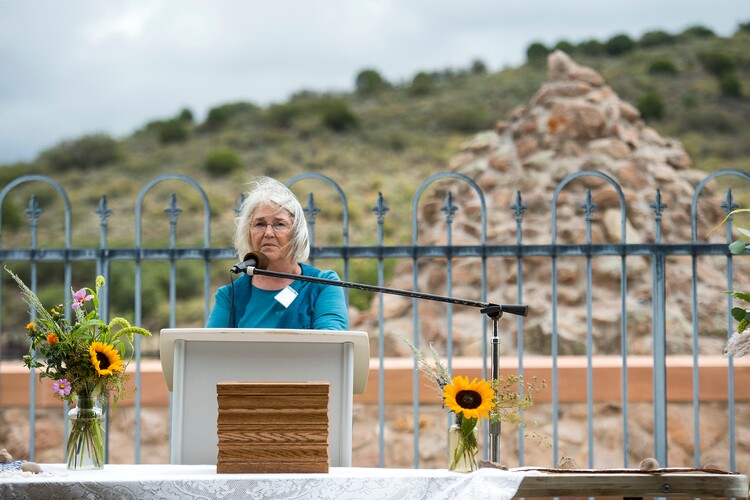St. George • More than 166 years since the Mountain Meadows Massacre, the relationships between the descendants of the nearly 100 men, women and children slain by Mormon militiamen and The Church of Jesus Christ of Latter-day Saints have never been better.
On Sept. 11, 1857, militia members, and some Paiute allies they recruited attacked the California-bound emigrant wagon train from Arkansas and killed all the adults, along with children deemed old enough to remember the crime and its perpetrators.
Over the ensuing decades, there was little contact between the church and descendants of the emigrants who were slaughtered or the 17 children, ages 6 and under, who were spared.
“There really wasn’t much of a relationship,” said Patty Norris, president of Mountain Meadows Massacre Descendants. “I wouldn’t call it rocky; I would characterize it as rarely existing at the time.”

(Chris Detrick | The Salt Lake Tribune) Patty Norris speaks at a Mountain Meadows Massacre memorial service in 2017.
What little interaction that did exist was fraught by the atrocity itself, the subsequent cover-up and the tall tales many Latter-day Saints related over the years to rationalize what is now accepted as an inexcusable assault.
After the massacre, many leaders and members of Utah’s predominant faith blamed the victims. One unfounded allegation was that members of the Arkansas wagon train poisoned Corn Creek, a spring near Fillmore in central Utah, killing cattle and several people who ate the contaminated beef.
Others insisted some of the emigrants were Missourians who were involved in the 1844 assassination of church founder Joseph Smith. Some Latter-day Saints also pointed to the slaying of beloved church apostle Parley P. Pratt a few months before the Utah massacre. Pratt was gunned down in Arkansas by the estranged husband of one of his plural wives.
All those allegations have long since been debunked, but the lies and justifications persisted.
“There was a lot of mistrust and animosity toward the church from descendants because there was no formal apology and no cooperation,” said Phil Bolinger, president of the Mountain Meadows Monument Foundation. “In our minds, our ancestors’ graves were owned, controlled and maintained by the perpetrators.”
(Courtesy of Phil Bolinger) Phil Bolinger, president of the Mountain Meadows Monument Foundation, and Dana Moody, daughter of historian Juanita Brooks.
Relations took a turn for the better in the 1990s, when then-church President Gordon B. Hinckley toured the massacre site. Archaeologist Ben Pykles, the church’s director of historic sites, said the church leader was appalled by the dilapidated condition of the original monument over the gravesite and decided to replace it with something nicer and more respectful.
Upon his return to Salt Lake City, Hinckley invited massacre descendants to meet with him.
“He ran different conceptual designs by them for how that place could be restored and let them choose which design they thought was best,” Pykles said, adding Hinckley dedicated the monument in 1999.
(Steve Griffin | The Salt Lake Tribune) An emotional Henry B. Eyring lowers his head while speaking during a Mountain Meadows Massacre memorial service in 2007.
Another healing moment came at a 150th anniversary memorial service for victims of the massacre, at which Latter-day Saint apostle Henry B. Eyring essentially apologized for Latter-day Saints’ role in the crime.
Church officials and descendants have also worked together to host subsequent gatherings and to secure recognition of the site in 2011 as a National Historic Landmark. In addition, the church has paid for more monuments and interpretive markers and worked with the descendants on the appropriate language for the signs.
Pykles said most of the monuments and educational signs are on land owned by the church, which pays for the site’s operational and maintenance expenses. The latest example of the two sides’ collaborative approach is their work to ensure the protection of three additional potential gravesites that were discovered last year.
Recent books that correct the historical record about the massacre — most notably the “Massacre at Mountain Meadows,” co-written by Latter-day Saint historians Richard E. Turley Jr., Ronald W. Walker and Glen M. Leonard in 2011 — have contributed to the thaw in relations.
Today, Bolinger and Norris say they regard Turley, Pykles and current and former church leaders and staffers as dear friends. Church officials say those sentiments are reciprocal.
“It’s gratifying to see the progress that has been made – not just in relationships but in the things we have accomplished,” said Pykles, steering much of the credit to the descendants’ groups for their dedication and ability to work together.
(Mark Eddington | The Salt Lake Tribune) The site of the Mountain Meadows Massacre is shown in early December 2023.
Still, Bolinger noted, for all that is good in the relationship, it is hard to right an event that was so horrifically and grievously wrong.
“The massacre,” he said, “is still known as the worst black mark on the history of the Mormon church.”
Read more here about the discovery of the three rock piles some believe could hold the remains of massacre victims.
Editor’s note • This story is available to Salt Lake Tribune subscribers only. Thank you for supporting local journalism.








